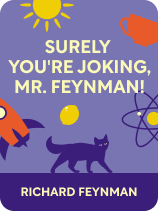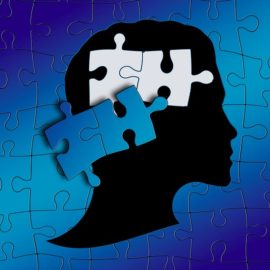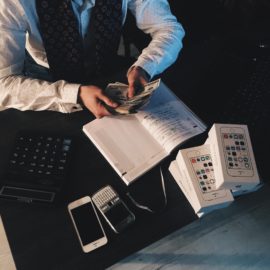

This article is an excerpt from the Shortform book guide to "Surely You're Joking, Mr. Feynman!" by Richard Feynman. Shortform has the world's best summaries and analyses of books you should be reading.
Like this article? Sign up for a free trial here.
How was Richard Feynman a nuisance at philosophy lectures? How did the atomic bomb change his life? How did he react to winning the Nobel Prize?
Richard Feynman’s scientific discoveries were merely one result of his lifelong love of learning, his spirit of adventure, and his determination to live life to its fullest. His memoir demonstrates his drive to solve puzzles, his joy at new discoveries, and his sense of inquisitive delight.
Here’s our overview of Surely You’re Joking, Mr. Feynman!
Overview of Surely You’re Joking, Mr. Feynman!
Unlike most award-winning scientists, Richard Feynman is more commonly remembered for his quirky wit, his adventurous spirit, and his colorful personality than for his achievements in the world of physics. Feynman began his career as a young theoretician working on the Manhattan Project to develop the atomic bomb during World War II. He went on to do research at Cornell and Caltech, and he was awarded the Nobel Prize in 1965 for his work on quantum mechanics.
However, that’s not the story Feynman wants to tell. After all, his discoveries in the realm of science were merely one result of his lifelong love of learning and adventure—of seeking out new experiences, exploring new skills, widening his horizons, and living life to its fullest. Throughout his tales runs a thread of inquisitive delight that shows how intellectual rigor and persistence can go hand-in-hand with excitement and fun.
Published in 1985, Surely You’re Joking, Mr. Feynman! doesn’t take the form of a traditional autobiography, and it doesn’t hit all the highlights of Feynman’s career. Instead, it’s a collection of Feynman’s personal stories as recorded by his friend Ralph Leighton and edited into a roughly chronological sequence. There’s little discussion of Feynman’s scientific work, but much about Feynman’s drive to solve puzzles, his joy at new discoveries, and his childlike ability to turn every situation into a game (or even, on occasion, a prank).
We’ll chart the outline of Feynman’s life from his early college days, through his years as part of the team that developed the atomic bomb, and finally to his academic career. We’ll then examine the personal values that permeate Feynman’s stories of his life: curiosity, persistence, the importance of teaching, scientific rigor, and most of all, having fun.
The Life of Richard Feynman
Rather than focusing on the major events in Richard Feynman’s biography, the stories in Surely You’re Joking, Mr. Feynman! take place around them. Feynman shares the details of his life through the incidents and adventures he most liked to talk about, rather than what others might consider more significant, such as his research in quantum mechanics or his work on the atomic bomb. In this section, we’ll explore the shape of Feynman’s life, from his years in school at Princeton and MIT, his participation in the Manhattan Project, and his return to the academic world, during which (and much to his annoyance) he earned a Nobel Prize.
Richard Feynman was born in New York on May 11, 1918. He attended the Massachusetts Institute of Technology (MIT) from 1935-1939 and was reluctant to leave after finishing his undergraduate work. However, MIT’s rules required its undergraduates to complete their advanced degrees elsewhere, so Feynman did his graduate studies at Princeton University until earning his doctorate in 1942. Although he found Princeton to have a stuffier, more formal culture than MIT, Feynman describes its physics laboratory as a playground, not unlike his cluttered workshop at home. Moving to Princeton was a blessing in that it pushed him to learn what the rest of the world was like, in terms of academics, people, and how physics was done.
While at Princeton, Feynman spent time with groups outside the physics department so he could learn what was going on in their fields. He says he was a nuisance at philosophy lectures because he had a habit of asking for definitions of fuzzy philosophical concepts. He enjoyed biology because there were so many interesting questions that scientists hadn’t been able to solve yet. He met scientists who could easily see mathematical problems in their heads, whereas Feynman had to grind away at them. He also gave a lecture that famous scientists such as Albert Einstein attended. This made him extremely nervous until the moment his presentation began and the science swept him away.
The Manhattan Project
As Feynman approached the end of his graduate studies, the US entered the Second World War. Feynman would contribute his intellectual gifts as part of the theoretical team that developed the atomic bomb. While Feynman would begin as a low-ranking recruit, he would play an important role in the advancement of the atom bomb project, though the ultimate success of his military mission would coincide with a great personal tragedy.
Like many Americans, Feynman felt it was his duty to contribute to the war effort, but he didn’t want to go to army boot camp; he believed he could better serve in a technical position. While he was still working on his Ph.D., a general came to Princeton looking for physicists to recruit, and Feynman volunteered, even though at the time very few people even understood what a physicist was. Feynman says his first job was working on an analog computer to help artillery target enemy aircraft—work that centered on tinkering with gears and engineering design, rather than Feynman’s area of expertise, which was theoretical physics.
After earning his doctorate, Feynman was recruited into the top-secret Manhattan Project team at Los Alamos, New Mexico, to develop the atomic bomb. In the beginning, he was a low-ranking member of the theoretical physics team whose first assignment was to consult with various engineering groups. When the scientists arrived at Los Alamos, the facilities were still under construction, so the experimental physics group lent a hand while theoreticians such as Feynman started work in whatever space was available. Despite his Ph.D., Feynman recalls that he wasn’t knowledgeable about nuclear physics, and he felt he had a lot of catching up to do.
Feynman also admits to being a troublemaker, sometimes accidentally and sometimes on purpose. For example, when he was assigned a room in the dormitory for scientists, he decided that he didn’t want a roommate, so he would ruffle the bed and leave some of his wife Arline’s belongings around so that it looked like she was with him, when in fact she was convalescing at a hospital in Albuquerque. Unknown to him at the time, the fact that he was supposedly living with a woman in a men-only dorm went up the chain of command and caused a policy ruckus at the highest level of the project’s management.
However, Feynman claims that the group at Los Alamos he probably irritated the most were those in charge of censoring the mail. He and his wife wrote to each other regularly, but certain topics, details, or even words (such as the fact that the mail was being censored) weren’t allowed in correspondence. Feynman grew so frustrated by this that he and his wife started writing in code, which drove the mail censors crazy. The struggle between Feynman, his wife, and the censors grew to such a contest that he began to place bets on what he would or wouldn’t be able to get past them.
Back to Academia
After the intense pace and pressure of working on the Manhattan Project, Feynman had to readjust to the life of an ordinary research professor. Feynman describes his difficulties finding his scientific inspiration again as he reentered the academic world. First, he had to learn what it meant to be a teacher before finding the place that would become his academic home and doing the work that would earn his Nobel Prize.
Feynman’s first position after leaving Los Alamos was a professorship at Cornell University. There, he had to start his life over, having lost his wife and his four-year wartime job. He had a hard time motivating himself to do research, so, instead, he focused on teaching. Feynman says that since he was young and inexperienced, he didn’t appreciate how much energy went into devising lessons and classes. When it came to doing research, he felt like a burned-out fraud, when in fact he was making great strides in honing his teaching skills. It was only when a close friend told him as much that he stopped feeling guilty about not producing the next breakthrough in physics.
Feynman recalls having a life-changing inspiration after several universities offered him prestigious research positions that he felt overstated his talents: You’re not responsible for living up to other people’s expectations. Once he accepted that it wasn’t his job to live up to some glorified academic ideal, he gave himself permission to play—in other words, to direct his research to questions in physics that he found personally interesting, instead of what might be considered “important” by the science community at large. Once he made that shift in his attitude, he found that his work became fun again. Research ideas began to flow once more.
Richard Feynman’s Values
Though Feynman’s recollections in his memoir may seem to bounce from topic to topic at random, they all exemplify certain key values that underlie Feynman’s idiosyncratic personality. At Feynman’s core is a deep love of learning, which expresses itself in a variety of ways. We’ll explore how Feynman’s values shaped his approach to problem-solving, teaching, intellectual honesty, and living life to its fullest.
Curiosity and Persistence
When Feynman talks about his life, one trait that stands out is his determination to understand how and why things work. He applied his curiosity to everything in life, not merely his scientific endeavors, and coupled it with a dogged persistence that made him stand out from his peers, often in unusual ways. Feynman’s childhood curiosity led him to pursue an education in math and science, but, as an adult, his curious nature expanded his horizons into fields such as safecracking and artistic expression.
Feynman recalls that as far back as his early teens, he was already tinkering with electronics. For him, it was more like play than formalized science or engineering. He didn’t follow any standard procedures—instead, he fiddled with wires, gears, and bulbs and observed what worked and what didn’t. He bought broken radios and tried to fix them, ran electrical wires all over his home, devised his own burglar alarm system, and almost inadvertently set his house on fire. Every project, both his failures and successes, was accomplished by nonstop trial and error. What Feynman took away from his early years was that persistence is the key to solving problems.
Feynman was so driven to solve problems that in school, he’d invent math puzzles for himself. This pushed him ahead of other students, who’d come to him with problems of their own. Feynman claims to have worked out many of the principles of trigonometry just for kicks and even invented his own form of mathematical notation because he didn’t like the ones used in his textbooks. All of this garnered him a reputation as a budding genius, a label that he frequently downplays, instead attributing his success to perseverance. He also says that by approaching math and science as play, he worked out shortcuts to mathematical problems that made him seem smarter than he actually was.
One thing Feynman discovered through his childhood exploration was that the world was a more complicated place than the simplified version in his textbooks, and this drove his curiosity further. When in college, he’d carry a toy microscope around campus so he could observe things such as ant behavior. When he took a summer job at a metal-plating company, he worked out chemical processes by trial and error, even though he wasn’t an expert in the field. Even in the case of puzzles where he could have looked up the answer, Feynman says that he didn’t because that would have spoiled the fun. To scratch his curiosity’s itch, he felt compelled to figure things out for himself.
The Importance of Teaching
While Feynman injected his lifelong learning with a casual sense of fun and exploration, one thing he took very seriously was his role as a teacher. Feynman explains that teaching serves two vital functions in his life: It keeps him engaged with the underlying principles of his field, and it allows him to make a positive contribution to the world. In his memoir, he describes the personal benefits he derives from teaching and highlights two specific examples where his beliefs on the subject clashed with those of others, once in Brazil and once in California.
Feynman is insistent that he’d never consider working in a nonteaching position. From a purely personal perspective, it forces him to review and reassess everything he assumes that he knows about the field of physics. He finds that the process of teaching those ideas will occasionally lead to questioning them and finding new approaches to problems and theories that wouldn’t have occurred to him otherwise. Teaching also keeps his mind active on those occasions when he doesn’t have a pressing theoretical problem to solve. In other words, teaching is good for the mind, as much for the instructor as it is for the students.
During a sabbatical year in Brazil in which Feynman taught science to prospective science teachers, he came across a peculiar phenomenon. His students appeared to have learned many scientific facts without understanding anything about them. When he pushed them to apply their knowledge through practical exercises, they couldn’t. He discovered that previously, his students had learned by rote memorization in order to pass a standardized test. Feynman recalls being horrified that this was how future teachers were trained, and he said so during a lecture he gave to the Brazilian teaching establishment. He explained that passing tests isn’t the point of education. Without practical application, there can be no learning.
This truth came home for Feynman years later when he served on a California state committee responsible for selecting math and science textbooks. This was during a time when the US was trying to catch up with the Russians post-Sputnik by emphasizing science and math. When Feynman actually read the texts under review, he was shocked to find that the books’ authors apparently didn’t understand their own subjects. The books also tended to be full of abstract concepts without applications that students could try on their own. Feynman insisted the textbooks he reviewed would do students a disservice and discourage learning instead of providing a real-world foundation for knowledge that would serve students later in life.
It was all for naught. Budget cuts to California’s Board of Education put the program on a back burner and severely restricted the number and quality of textbooks Feynman’s committee could recommend. When asked to do the same for science textbooks the following year, Feynman declined to participate any further.
Scientific Rigor
Feynman believes that teaching math and science is especially important in the modern age, and not just because of technological advances. He argues that understanding math and science requires a level of intellectual honesty that other fields lack. Feynman’s experience in the scientific world shines a light on the value of questioning others, questioning yourself, and having the integrity to admit when you’re wrong.
The first of these principles can best be summed up as “Don’t take anyone’s word for granted, not even the so-called experts.” Feynman gives the example of a physics paper that was published on a topic that he didn’t fully understand. After Feynman wracked his brain at the topic for a while, his sister suggested that he approach it like a student doing a homework assignment and recheck all of the paper’s math. Doing so—starting from first principles and working through the paper’s argument for himself—unlocked the puzzle in his mind and even provided him with insights that he was able to apply in his own work.
The research that came from that stroke of insight led Feynman and his colleague Murray Gell-Mann to solve the theoretical problem of beta decay—the process by which subatomic particles emit a particular kind of radiation. Feynman and Gell-Mann’s solution also showed that the results of many beta decay experiments were flawed, which highlights another aspect of Feynman’s thoughts on intellectual honesty: Good scientists must call attention to any possible doubt about their work. When reporting the results of an experiment or study, it’s crucial to acknowledge any variables, theories, or conditions that might call your conclusions into question. Questioning yourself is an essential part of overcoming your own bias.
Science, after all, is the process by which you can short-circuit bias to arrive at the truth, but Feynman says it’s every scientist’s job to make sure the system works as advertised. There are two ways to do this: by repeating other scientists’ work to make sure that the same results can be achieved, and by reporting the results of any study you conduct, whether or not they agree with your theories. If any field of knowledge doesn’t encourage both of these practices—either by discouraging repeat experiments or hiding contradictory data—then that field is pseudoscience and will remain so until more rigorous standards are established.
Having Fun
While Feynman took his stance on scientific integrity and the importance of education seriously, he was never very serious about himself or his importance to the world. In fact, Feynman states that not feeling responsible for the world is his secret to happiness. Instead, Feynman talks about being open to new experiences, grabbing opportunities as they appear, and having the confidence to fake his way through.
He learned his first lessons about loosening up in college, where his fraternity brothers taught him how to socialize and dance. Thanks to this, one time Feynman accidentally found himself at a dance party for deaf students. Instead of leaving, Feynman relaxed into the occasion, despite feeling like a traveler in a foreign country. Over time, Feynman says that he learned there are many interesting experiences in life if you’re patient enough to wait for them and go along when they present themselves.
One occasion when Feynman grabbed his chance at adventure was when he was invited to attend a scientific conference in Japan. He and his colleagues were put up in a western-style hotel, but Feynman felt like he was missing out on the authentic Japanese experience. To his hosts’ consternation, he pleaded to be housed at a traditional Japanese hotel, despite the hassle he’d create for himself getting to and from the conference. Feynman won out, changed hotels, and enjoyed his more genuine experience of Japanese culture so well that he returned to the country many times. He explains that in many ways he found the culture and customs of Japan far more civilized than those of the United States in terms of courtesy and hospitality.
Another country Feynman grew to love was Brazil, where his enjoyment of travel merged with another hobby of his—playing drums. He’d started drumming in Los Alamos as a way to relax, though he never grew to be as good as a professional musician. Nevertheless, he grabbed at the chance to play drums for an amateur samba band in Rio—the “Fakers from Copacabana.” There, he learned to pretend to be a pro and let his show of confidence carry him along. As part of that group, he got to perform at the annual Carnaval celebrations. Feynman says that the fact that his playing wasn’t perfect didn’t matter. What matters is snapping up every chance at the joy that life provides.

———End of Preview———
Like what you just read? Read the rest of the world's best book summary and analysis of Richard Feynman's "Surely You're Joking, Mr. Feynman!" at Shortform.
Here's what you'll find in our full Surely You're Joking, Mr. Feynman! summary:
- The memoir of award-winning scientist Richard Feynman
- A walk through Feynman's life, from college to winning the Nobel Prize
- Why enjoying life is just as valuable as your education






